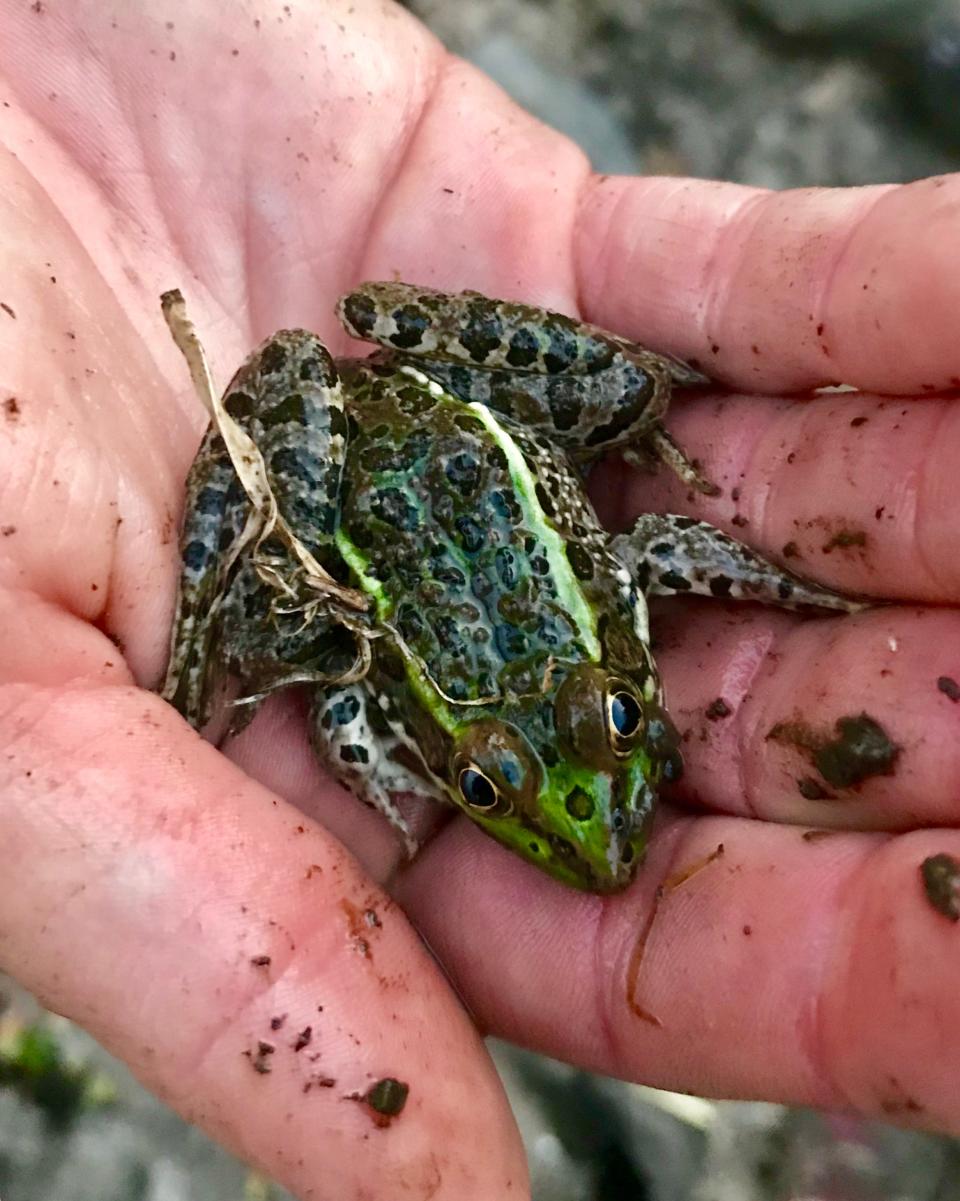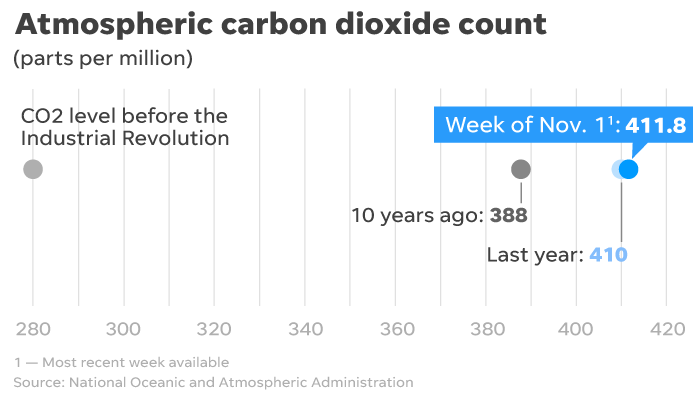Climate Point: Biden-Harris win sparks hope for climate action
- Oops!Something went wrong.Please try again later.
- Oops!Something went wrong.Please try again later.
Welcome to Climate Point, your weekly guide to climate, energy and environment news from around the Golden State and the country. In Palm Springs, Calif., I’m Mark Olalde.
Joe Biden will be the next president of the United States after receiving at least 5 million more votes than President Donald Trump. The incumbent, however is refusing to go quietly and continues to publicly lie about the results. It remains unclear how far Trump and some Republicans will take their dangerous claims that the fair election was rigged, but Biden and Vice President-elect Kamala Harris have already gotten to work, including on environmental issues.
The Democratic ticket has elicited a wide range of reactions for potential environment policies with months still to go before the inauguration. Politico has the intel on potential cabinet nominees, and departments with the largest impact on the environment aren't looking nearly as progressive as the left had hoped. Bloomberg reports that Biden is expected to quickly unload on Trump's years of environmental deregulation. Meanwhile, Grist has the details on the personnel making up the environmental portion of his transition team.
Perhaps my favorite bit of early news, though, is that Biden's recently updated transition plan calls for the plugging of oil wells and rehabilitation of abandoned mines, issues I have investigated for years.
Here's some other important reporting....

MUST-READ STORIES
Identity politics. Neil Chatterjee, until recently the chairman of the powerful Federal Energy Regulatory Commission, was demoted from his post by Trump. Chatterjee, a Republican, held moderate views on energy, and many observers were quick to assume his demotion stemmed from his openness to allowing renewable energy to compete in the marketplace. The true reason for knocking down the Indian American, at least in part, appear to be racist. E&E reports that key to the decision was Chatterjee's "unwillingness to go along with the Trump administration's governmentwide edicts against diversity training."
Intention vs. reality. The Nevada Independent writes that the Silver State's governor is aiming for a plan to reduce emissions "to zero or near-zero by 2050," but current policies are misaligned with that hopeful thinking. A new study argues that to meet the lofty goals, the state must accelerate the retirement of coal power plants, shift to electric vehicles and halt the use of gas in buildings.
Funding freeze. In another small strike against fossil fuels, Reuters reports, Toronto-Dominion Bank said it will refuse project-specific financial services for any oil and gas drilling in the Arctic Circle. Several other banks have come out with similar decrees, while drillers look ever-farther north as warming temperatures melt ice and make more land accessible for exploration.
Just Transition. Friend-of-the-newsletter Ryan Randazzo at The Arizona Republic is out with a new story about Arizona Public Service's proposal to make $144 million available for three communities that rely on employment at the utility's still-active coal-fired power plants. APS is Arizona's largest utility and has a history of throwing cash into elections to build itself a more favorable regulatory environment, making this positive announcement all the more significant. Several of the impacted communities are within the Navajo Nation and the Hopi Tribe, and the plan would "retain workers, electrify regions of the Navajo reservation that are off the power grid, and develop renewable energy projects like solar and wind plants."

POLITICAL CLIMATE
Interior influence. The Arizona Daily Star reports that Department of the Interior Secretary David Bernhardt, in a previous posting, attempted to influence another agency's decision to require a developer to analyze its project's impacts on a local river. Bernhardt's spokesperson, however, called the topic a "nonissue."
Clinching on climate. The post-election takes are coming as hot and fast as climate change, with pundits and writers trying to unpack the results of another wild political wide. Environment publication Earther got in on the action, trying to determine whether the Green New Deal — the audacious plan to address climate change and the Just Transition with the same energy as FDR's New Deal — hurt its supporters, as some politicos predicted. "Of the 93 House co-sponsors (of the Green New Deal) who ran for a seat in Congress’s lower chamber in 2020, only one lost reelection," they found. Questions remain whether other environmental questions such as fracking hurt Biden's vote count, but evidence points to climate at least not being a losing issue for liberals.
Feel the burn. It might sound backward, but in the oil and gas industry, burning off its own product instead of sending it to market is sometimes the most profitable decision. There are business reasons for this practice, but environmentalists believe that allowing it incentivizes the release of more climate-warming gas. The Colorado Sun reports that state regulators recently outlawed this in most cases, making it the state with the country's most comprehensive regulations on the topic.
THE REAL WILD WEST

It's often difficult to imagine what landscapes looked like before humans introduced the built environment, molding the world into straight lines and visually pleasing geometry. But the West — far from the East Coast's cities and the Midwest's flat sprawl of corn, wheat and soybeans — still holds easier-to-identify natural treasures. This week, I'm highlighting news on Western wildlife.
It ain't easy being green. Erin Stone at The Arizona Republic reports that the Phoenix Zoo is at the heart of a 25-year push to save the Chiricahua leopard frog. Since 2002, the amphibian has been listed as a threatened species under the federal Endangered Species Act. "Habitat degradation caused by development and human-driven climate change may prove to be longer-running threats than disease. These are the same threats many species face in the midst of what scientists call a sixth mass extinction," Stone writes.
Welcoming the wolves. Gray wolves, native to Colorado, have been markedly absent from the Centennial State for 75 years. That's now set to change, Colorado Public Radio reports. By narrowly passing Proposition 114, voters mandated that the state reintroduce the species by 2023. In a twist, the measure's supporters actually outspent the opposition, leaving hunters and ranchers on the losing end.
Where the buffalo roam. This one's just plain cool. High Country News used a map from environmental group The Nature Conservancy to analyze the potential for public and private dollars to be used to purchase land rights and keep important migration corridors clear. Take a look at what migration pathways look like in the West and how development threatens to bottleneck species' movements.
AND ANOTHER THING

So, what now? I don't typically share opinion pieces in this newsletter, but with the election results in, this one from Leah Stokes, a political scientist who works on climate change issues at UC Santa Barbara, is an important read. Climate change was a key issue in the presidential election, and Biden will take office with a mandate to address the matter, from electrifying transport to retiring coal plants. "The best time to cut emissions was decades ago; the second-best time is today," she wrote in The Boston Globe.
Scientists agree that to maintain a livable planet, we need to reduce the atmospheric carbon dioxide concentration back to 350 ppm. We’re above that and rising dangerously. Here are the latest numbers:

That’s all for now. Don’t forget to follow along on Twitter at @MarkOlalde. You can also reach me at molalde@gannett.com. You can sign up to get Climate Point in your inbox for free here. And, if you’d like to receive a daily round-up of California news (also for free!), you can sign up for USA Today’s In California newsletter here. Wear a mask when you leave the house! Cheers.
This article originally appeared on USA TODAY: Climate Point: Biden-Harris win sparks hope for climate action

